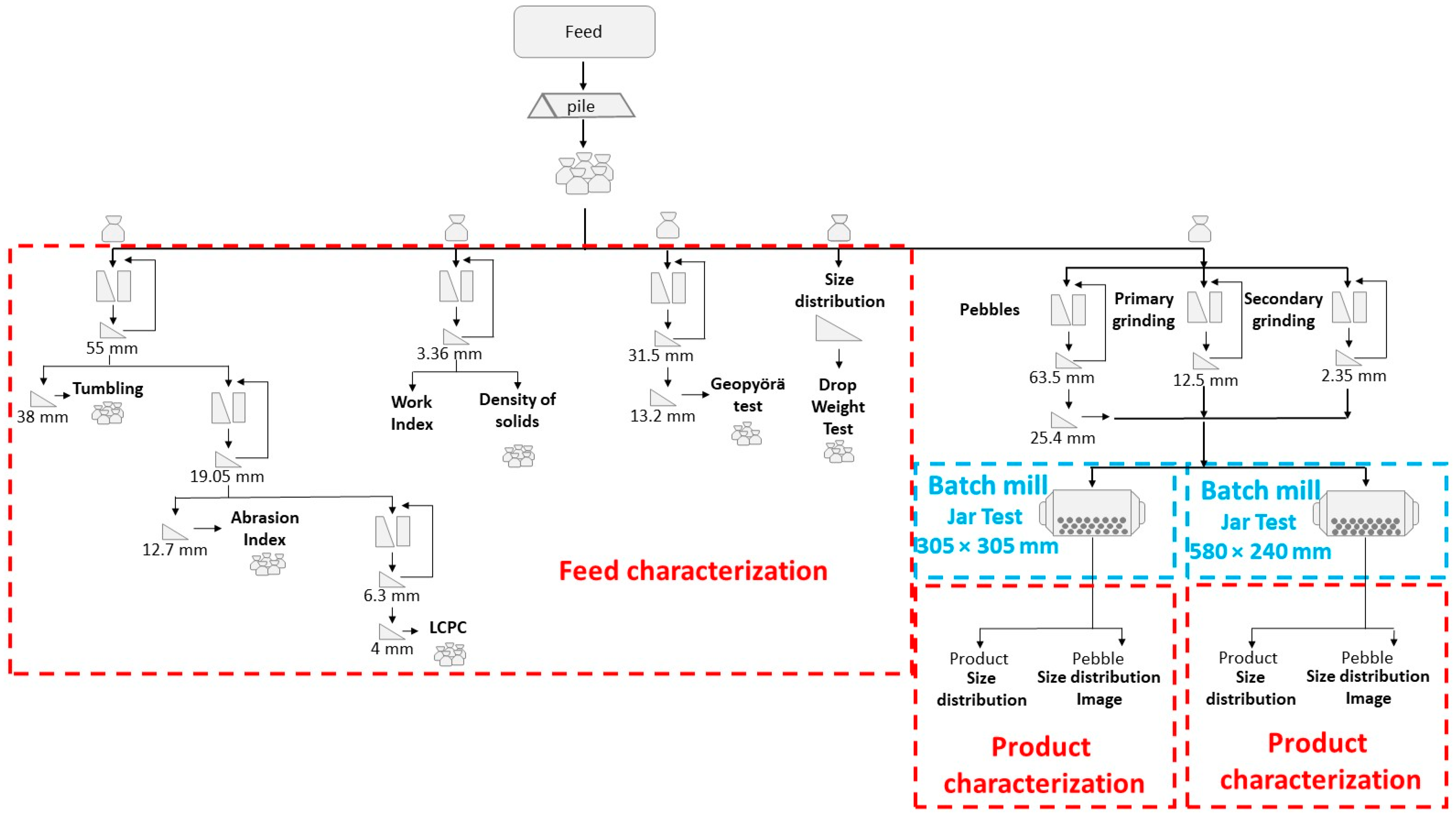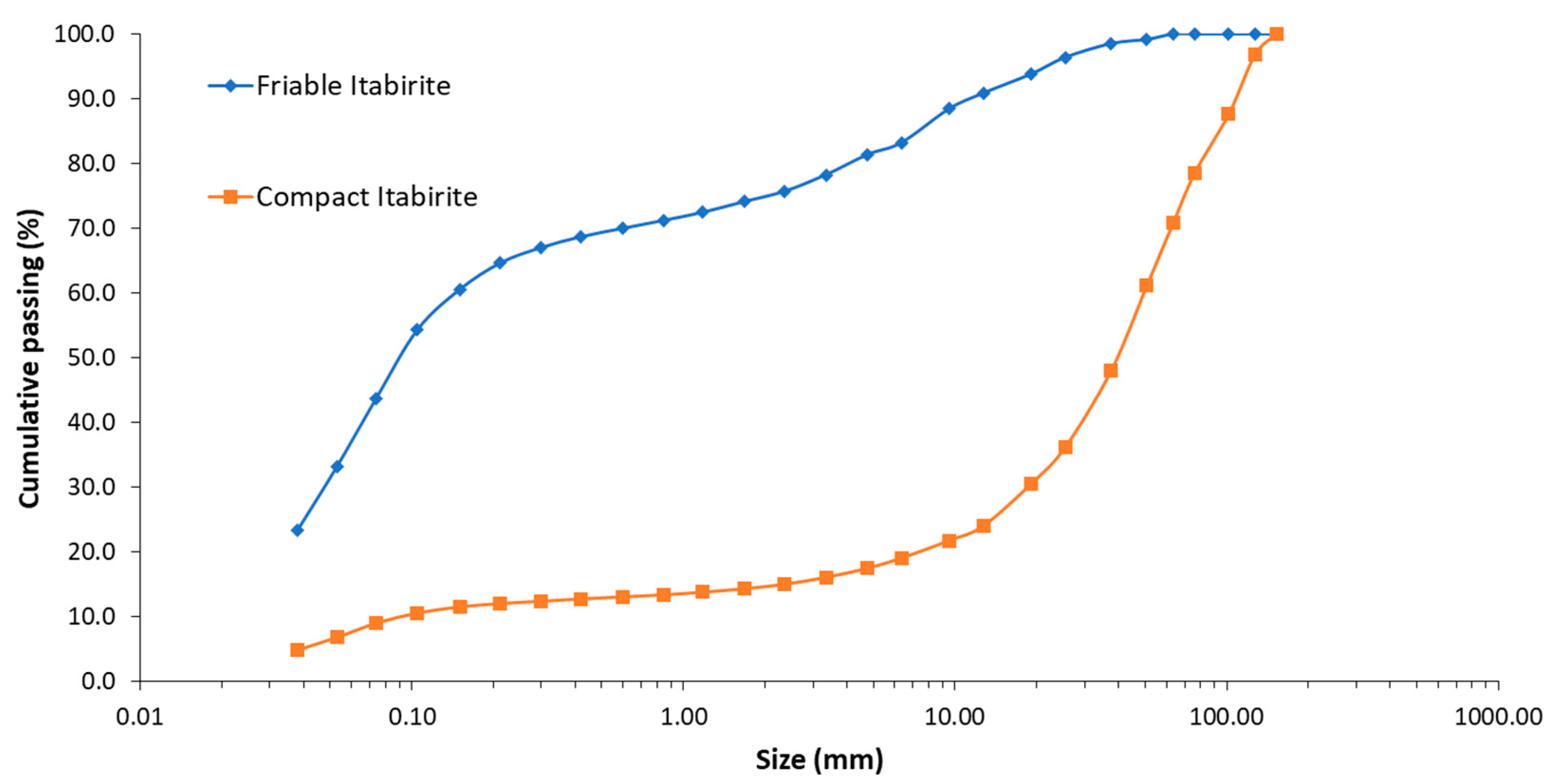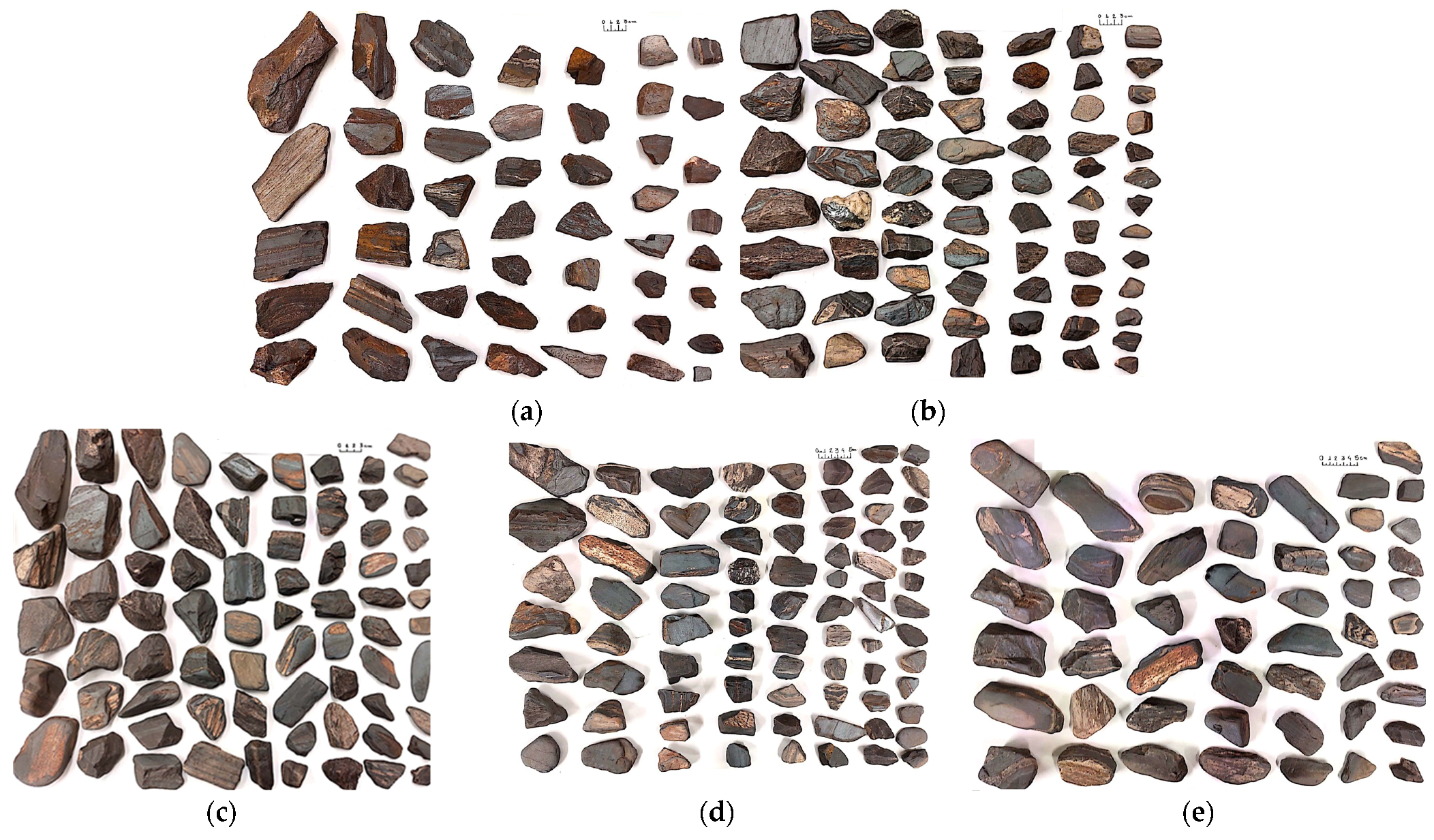Study on Partial Replacement of Metal Grinding Ball with Pebbles When Grinding Itabirite Ores
Abstract
:1. Introduction
2. Materials and Methods
3. Results and Discussion
4. Conclusions
Author Contributions
Funding
Data Availability Statement
Acknowledgments
Conflicts of Interest
References
- Norgate, T.; Jahanshahi, S. Reducing the Greenhouse Gas Footprint of Primary Metal Production: Where Should the Focus Be? Miner. Eng. 2011, 24, 1563–1570. [Google Scholar] [CrossRef]
- Bearman, R.A. Step Change in the Context of Comminution. Miner. Eng. 2013, 43–44, 2–11. [Google Scholar] [CrossRef]
- ANM. Informe Mineral—2° Semestre; Agência Nacional de Mineração: Brasília, Brazil, 2019. [Google Scholar]
- Pinto, P.F.; Delboni, H., Jr. Comminution Circuits for Compact Itabirites. REM Int. Eng. J. 2016, 69, 355–359. [Google Scholar] [CrossRef] [Green Version]
- Dorr, J.V.N. Physiographic, Stratigraphic and Structural Development of the Quadrilatero Ferrifero Minas Gerais, Brazil; United States Government Printing Office: Washington, DC, USA, 1969.
- Rowland, C.A. Selection Of Rod Mills, Ball Mills, Pebble Mills and Regrind Mills. In Desingn and Installation of Comminution Circuits; Mular, A.L., Jergensen, G.V., II, Eds.; The American Institute of Mining, Metallurgical, and Petroleum Engineers: New York, NY, USA, 1982; pp. 239–439. ISBN 0-89520-401-0. [Google Scholar]
- Rowland, C.A. Selection of Rod Mills, Ball Mills and Regrind Mills. In Mineral Processing Plant Design, Practice and Control V.1; Mular, A.L., Halbe, D.N., Barratt, D.J., Eds.; Society for Mining, Metallugy, and Exploration, Inc.: Littleton, CO, USA, 2002; pp. 733–735. [Google Scholar]
- Ballantyne, G. Quantifying the Additional Energy Consumed by Ancillary Equipament and Embodied in Grinding Media in Comminution Circuits. In Proceedings of the SAG Conference, Vancouver, BC, Canada, 22–26 September 2019. [Google Scholar]
- Dowling, E.C.; Korpi, P.A.; Mclvor, R.E.; Rose, D.J. Application of High Pressure Grinding Rolls in an Autogenous-Pebble Milling Circuit. In Proceedings of the SAG Conference, Vancouver, BC, Canada, 30 September–3 October 2001; pp. III-194–III-201. [Google Scholar]
- Hahne, R.; Palsson, B.I.; Samskog, P.-O. Abrasion Tests on Iron Ore Evaluated by Multivariate Statistics. In Proceedings of the SAG Conference, Vancouver, BC, Canada, 30 September–3 October 2001; pp. I-326–I-338. [Google Scholar]
- Yahyaei, M.; Limpus, A.; Russell, J.; Toor, P.; Powell, M. Improving Liner Design for Effeciency. In Proceedings of the SAG Conference, Vancouver, BC, Canada, 20–24 September 2015; pp. 1–15. [Google Scholar]
- Powell, M.S.; Benzer, H.; Dundar, H.; Aydogan, N.; Adolfsson, G.; Partapuoli, A.; Wikstrom, P.; Fredriksson, A.; Tano, K. LKAB Autogenous Milling of Magnetite. In Proceedings of the SAG Conference, Vancouver, BC, Canada, 25–28 September 2011; p. 24. [Google Scholar]
- Crocker, B.S. Pebble Mills. In SME Mineral Processing Handbook; Weiss, N.L., Ed.; Society of Mining Engineers: New York, NY, USA, 1985; Volume 1, pp. 3C94–3C107. ISBN 0-89520-433-6. [Google Scholar]
- Markstrom, S. Commissioning and Operation of the AG Mills at the AITIK Expansion Project. In Proceedings of the SAG Conference, Vancouver, BC, Canada, 25–28 September 2011. [Google Scholar]
- Nkwanyana, S.; Loveday, B. Addition of Pebbles to a Ball-Mill to Improve Grinding Efficiency. Miner. Eng. 2017, 103–104, 72–77. [Google Scholar] [CrossRef]
- Nkwanyana, S.; Loveday, B. Addition of Pebbles to a Ball-Mill to Improve Grinding Efficiency—Part 2. Miner. Eng. 2018, 128, 115–122. [Google Scholar] [CrossRef]
- Loveday, B. The Small Pebble Process for Reducing Ball and Power Consumption in Secondary Grinding. In Proceedings of the XXV Internacional Mineral Processing Congress, Brisbane, Australia, 6–10 September 2010; Volume 2, pp. 981–989. [Google Scholar]
- Loveday, B.K. The Use of Small Pebbles for Secondary Grinding. In Proceedings of the SAG Conference, Vancouver, BC, Canada, 25–28 September 2001; pp. 149–158. [Google Scholar]
- Shahbazi, B.; Jafari, M.; Parian, M.; Rosenkranz, J.; Chehreh Chelgani, S. Study on the Impacts of Media Shapes on the Performance of Tumbling Mills–A Review. Miner. Eng. 2020, 157, 106490. [Google Scholar] [CrossRef]
- Bond, F.C. The Third Theory of Comminution. Min. Eng. 1952, 193, 484–494. [Google Scholar]
- McIvor, R.E. Determining the Bond Efficiency of Industrial Grinding Circuits; Global Mining Guidelines Group: Ormstown, QC, Canada, 2015. [Google Scholar]
- Bergstrom, B.H. Abrasiveness. In SME Mineral Processing Handbook; SME Society for Mining, Metallugy, and Exploration: New York, NY, UYA, 1985; pp. 30–70. [Google Scholar]
- Delboni, H., Jr.; Chieregati, A.C.; Bergerman, M.G. Development and Validation of Ore Characterisation Test and Its Use in Variability Campaigns of Comminution Circuits. In Proceedings of the XXV Internacional Mineral Processing Congress, Brisbane, Australia, 6–10 September 2010. [Google Scholar]
- Napier-Munn, T.J.; Morrell, S.; Morrison, R.D.; Kojovic, T. Mineral Comminution Circuits: Their Operation and Optimisation, 1st ed.; Julius Kruttschnitt Mineral Research Centre: Indooroopilly, Australia, 1996; ISBN 064628861X. [Google Scholar]
- Bueno, M.; Torvela, J.; Chandramohan, R.; Chavez, T.; Liedes, T.; Powell, M. The Double Wheel Breakage Test. Miner. Eng. 2021, 168, 106905. [Google Scholar] [CrossRef]
- Rosa, A.C.; de Oliveira, P.S.; Donda, J.D. Comparing Ball and Vertical Mills Performance: An Industrial Case Study. In Proceedings of the XXVII International Mineral Processing Congress, Santiago, Chile, 20–24 October 2014; pp. 44–52. [Google Scholar]
- Ballantyne, G. Assessing Comminution Energy Efficiency with the Size Specific Energy (SSE) Approach. In Proceedings of the 16th European Symposium on Comminution & Classification, Leeds, UK, 2–4 September 2019; pp. 29–30. [Google Scholar]
- Pereira Lima, N.; Valadão, G.E.S.; Peres, A.E.C. Effect of Particles Size Range on Iron Ore Flotation. Rem Rev. Esc. Minas 2013, 66, 251–256. [Google Scholar] [CrossRef] [Green Version]
- Lima, N.P.; de Souza Pinto, T.C.; Tavares, A.C.; Sweet, J. The Entrainment Effect on the Performance of Iron Ore Reverse Flotation. Miner. Eng. 2016, 96–97, 53–58. [Google Scholar] [CrossRef]
- Norgaard, S. Laboratory Test Work and Equipament. In SME Mineral Processing and Extractive Metallurgy Handbook; Dunne, R.C., Kawatra, S.K., Young, C.A., Eds.; Society for Mining, Metallugy, and Exploration, Inc.: Englewood, CO, USA, 2019; pp. 115–145. ISBN 9780873353854. [Google Scholar]
- Lynch, A.J. Comminution Handbook; Australasian Institute of Mining and Metallurgy: Carlton, Australia, 2015. [Google Scholar]
- Gomes, W.L.; Delboni Júnior, H.; Chieregati, A.C.; Jatobá, T.L.A. Development of Ball Mill Test for Simulation of Industrial Circuit. Rem Rev. Esc. Minas 2016, 69, 91–96. [Google Scholar] [CrossRef] [Green Version]





| Parameter | Mill 1 | Mill 2 | |||
|---|---|---|---|---|---|
| Primary Grinding | Secondary Grinding | Primary Grinding | Secondary Grinding | ||
| Diameter × length (mm) | 305 × 305 | 580 × 240 | |||
| Mill charge volume—J (% volume) | 30 | ||||
| Ore bulk density (g/cm3) | 2.49 | 2.42 | 2.49 | 2.42 | |
| Grinding media mass (g) | Proportion of pebbles in the media charge (% volume) | steel balls | pebbles | steel balls | pebbles |
| 0 | 31,104 | - | 88,682 | - | |
| 10 | 27,994 | 1417 | - | - | |
| 25 | 23,328 | 3542 | 66,511 | 10,100 | |
| 50 | 15,552 | 7085 | 44,341 | 20,201 | |
| 100 | - | 14,171 | - | 40,403 | |
| Solids content (g) | 4226 | 19,175 | |||
| Solids content (% mass) | 74 | ||||
| Speed (% of critical speed) | 72 | ||||
| Ball Size | Primary Grinding | Secondary Grinding |
|---|---|---|
| 65 mm | 34% | - |
| 50 mm | 43% | 40% |
| 40 mm | 17% | 45% |
| 25 mm | 6% | 15% |
| Sample | Chemical Analysis | Mineralogical Analysis | Density of Solids | ||
|---|---|---|---|---|---|
| Fe (%) | SiO2 (%) | Hematite (%) | Quartz (%) | (g/cm3) | |
| Friable Itabirite | 39.3 | 41.6 | 56.4 | 41.3 | 3.61 |
| Compact Itabirite | 39.1 | 42.4 | 54.0 | 42.6 | 3.65 |
| Test | Friable Itabirite | Compact Itabirite |
|---|---|---|
| Abrasion Index | 0.06 | 0.40 |
| LCPC | 104 | 363 |
| Work Index (kWh/t) | 6.5 | 6.8 |
| Drop Weight Test (Axb) | - | 88 |
| Tumbling (ta) | - | 0.48 |
| Geopyörä–Ecs (kWh/t) | 0.17 | 0.56 |
| Mill | 1 | 2 | |||||||
|---|---|---|---|---|---|---|---|---|---|
| Proportion of Pebbles in the Media Charge | 0% | 10% | 25% | 50% | 100% | 0% | 25% | 50% | 100% |
| Grinding time | 3 min 30 s | 3 min 40 s | 4 min | 6 min | 20 min | 4 min | 5 min | 5 min | 25 min |
| Energy E (kWh/t) | 1.36 | 1.46 | 1.49 | 2.03 | 5.01 | 1.60 | 1.83 | 1.70 | 5.94 |
| Energy consumption (% base case) | Base case | +7.4 | +9.5 | +49.2 | +268 | Base case | +14.4 | +6.3 | +271 |
| SSE (kWh/t −1 mm) | 5.94 | 6.51 | 6.50 | 8.24 | 17.94 | 5.16 | 6.49 | 7.23 | 21.68 |
| Energy consumption SSE (% base case) | Base case | +9.5 | +9.4 | +38.7 | +202.0 | Base case | +25.7 | +40.11 | 320.1 |
| Pebble consumption (% product) | - | 10.1 | 5.9 | 14.1 | 38.2 | - | 10.2 | 16.3 | 31.9 |
| Ball consumption (% base case) | Base case | −10% | −25% | −50% | −100% | Base case | −25% | −50% | −100% |
| Slime −0.010 mm (increase base case) | Base case | 2.5% | 0.5% | 2.0% | 3.3% | ||||
| Mill | 1 | 2 | |||||||
|---|---|---|---|---|---|---|---|---|---|
| Proportion of Pebbles in the Media Charge | 0% | 10% | 50% | 100% | 100% opt | 0% | 25% | 50% | 100% |
| Grinding time | 10 min | 11 min 30 s | 20 min | 35 min | 30 min | 12 min | 16 min | 25 min | 30 min |
| Energy E (kWh/t) | 3.82 | 4.28 | 6.78 | 9.41 | 8.25 | 5.39 | 5.43 | 7.53 | 7.10 |
| Energy consumption (% base case) | Base case | +12.0 | +77.5 | +146.3 | +116.0 | Base case | +0.7 | +39.7 | +31.7 |
| SSE (kWh/t −150 um) | 11.64 | 12.69 | 18.54 | 25.20 | 21.44 | 19.12 | 19.24 | 26.29 | 28.18 |
| SSE (% base case) | Base case | +9.0 | +59.3 | +116.5 | +84.2 | Base case | +0.6 | +37.5 | +47.4 |
| Pebble consumption (% product) | - | 1.9 | 19.8 | 46.1 | 44.1 | - | 7.7 | 22.7 | 27.6 |
| Ball consumption (% base case) | Base case | −10% | −50% | −100% | −100% | Base case | −25% | −50% | −100% |
| Slime −0.010 mm (increase base case) | Base case | −1.0% | 1.6% | 1.5% | |||||
Disclaimer/Publisher’s Note: The statements, opinions and data contained in all publications are solely those of the individual author(s) and contributor(s) and not of MDPI and/or the editor(s). MDPI and/or the editor(s) disclaim responsibility for any injury to people or property resulting from any ideas, methods, instructions or products referred to in the content. |
© 2023 by the authors. Licensee MDPI, Basel, Switzerland. This article is an open access article distributed under the terms and conditions of the Creative Commons Attribution (CC BY) license (https://creativecommons.org/licenses/by/4.0/).
Share and Cite
Sanches, J.G.; Bergerman, M.G.; Delboni, H., Jr.; Lima, N. Study on Partial Replacement of Metal Grinding Ball with Pebbles When Grinding Itabirite Ores. Minerals 2023, 13, 512. https://doi.org/10.3390/min13040512
Sanches JG, Bergerman MG, Delboni H Jr., Lima N. Study on Partial Replacement of Metal Grinding Ball with Pebbles When Grinding Itabirite Ores. Minerals. 2023; 13(4):512. https://doi.org/10.3390/min13040512
Chicago/Turabian StyleSanches, Júlia Guimarães, Mauricio Guimarães Bergerman, Homero Delboni, Jr., and Neymayer Lima. 2023. "Study on Partial Replacement of Metal Grinding Ball with Pebbles When Grinding Itabirite Ores" Minerals 13, no. 4: 512. https://doi.org/10.3390/min13040512
APA StyleSanches, J. G., Bergerman, M. G., Delboni, H., Jr., & Lima, N. (2023). Study on Partial Replacement of Metal Grinding Ball with Pebbles When Grinding Itabirite Ores. Minerals, 13(4), 512. https://doi.org/10.3390/min13040512






